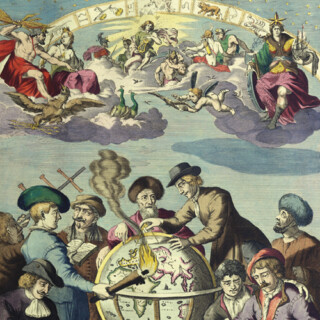Glossary of Terms for Collectors of Rare Maps, Atlases, Books, Globes and other related Scientific Objects.
When the edges of the boards are noticeably tapered. The method of holding pages or sheets together; may be simply stapled or sewn, or sewn and enclosed in wrappers, but most often refers to a "hard" binding or covers. This type of binding may be covered with cloth, various leathers, or paper over boards or other more exotic materials. The following terms relate primarily to leather bindings: Full binding: volume is entirely encased in leather (calf, sheep, morocco, etc.) Three quarter binding: volume has leather spine and corners that occupy approx. 3/4 of the space along top edge of board (cover). The remainder of the board is covered with marbled paper, plain paper, cloth, different leather, etc. Half binding: the spine and corner leather occupy only approximately 1/2 of top edge. Quarter binding: usually lacks leather corners and leather of the spine occupies only approx. 1/4 of the top edge. Refers to a blank page that is left intentionally in the book. It can be located at beginning of the book, at the end of a clearly marked division, and/or at the end of book. Also known as blank leaves or printer's blanks. French: Feuillets blancs Decoration, picture, or lettering that has been impressed into the binding with a metal stamp prepared for the purpose, resulting in a "blind" (meaning uncoloured) decoration, picture or lettering. Danish: Blindtryk The covers of a hard bound book; the boards are the stiff cardboard or paperboard that is usually covered with cloth or leather; and when covered with paper, the covers are properly referred to as "boards". Many pre-1850 books were issued by the publishers bound in boards (paper covered), allowing for an inexpensive binding that could later be replaced with leather by a hand book binder. Early (medieval) manuscript volumes were often bound between two oak boards, hence the probable origin of this term. The traditional terms in use for describing book formats are derived from early printing methodology and the size of early handmade sheets of paper. When two leaves (four pages when printed on both sides) were printed on a sheet so that it could be folded once, collated with other folded sheets and bound, the format of the volume was a "folio". When four leaves (eight pages) were printed on the same size sheet, which would later be folded twice, the format of the resultant volume was a "quarto" (four leaves). The term "octavo" relates to the sheet having eight leaves printed on it. A simple or elaborately designed label used to indicate ownership, which is usually found pasted to the inside of the front cover of a book. Any of a number of moth or fly larvae that tunnel through the pages of books leaving behind small channels, holes in individual leaves. A printing that occurs on both sides of a single leaf (see also broadside). French: Affiche A printing on a single sheet of paper and only on one side; the verso (other side) is blank. When printed on both sides, the sheet becomes a "broadsheet". French: Voir Affiche A stiff, coarsely woven, filled cloth used for less expensive, but stronger wearing, cloth book binding material.
Glossary
B
Beveled edges
Beveled edges

Binding
Binding

Blanks
Blanks
German: Weißes Blatt
Swedish: Blankt blad
Blind stamp
Blind stamp
Dutch: Blindstempeling
French: Motifs à froid
German: Blindprägung
Italian: Impressioni a secco
Spanish: Dorado en frio
Swedish: Blind tryck
Boards
Boards

Book formats
Book formats

Bookplate
Bookplate

Bookworm
Bookworm

Broadsheet
Broadsheet
German: Einblattdruck
Swedish: Ettbladstryc
Broadside
Broadside
German: Einblattdruck
Buckram
Buckram








